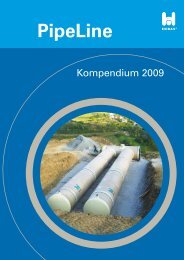PipeLine - Hobas Pipes
PipeLine - Hobas Pipes
PipeLine - Hobas Pipes
Create successful ePaper yourself
Turn your PDF publications into a flip-book with our unique Google optimized e-Paper software.
h <strong>PipeLine</strong> | Compendium 2009 | Page 17<br />
Isle of Grain Pipe Jacking<br />
h CC-GRP <strong>Pipes</strong> for Great Britain<br />
In addressing future demands for alternative<br />
supplies of gas, the UK has seen the construction<br />
of a number of new terminals for the importation<br />
of liquefied natural gas (LNG) one of which is<br />
sited at the Isle of Grain on the Thames estuary.<br />
For the most economic transportation of the gas<br />
it is cooled to achieve this liquid state and needs<br />
to go through a process of regasification for use<br />
in the UK gas grid. The latter process is no more<br />
than raising its temperature back to ambient. This<br />
requires heat and at the Isle of Grain this is being<br />
supplied by utilizing surplus heat from the existing<br />
Isle of Grain power station in the form of hot water.<br />
A twin pipeline system connects the station’s<br />
two plants, part of which is installed inside tunnels<br />
using HOBAS CC-GRP jacking pipes.<br />
For the first 2 drives the pipe lengths were two<br />
3 m pipes behind the shield with the remaining<br />
pipes being 6 m long. Every third pipe was fitted<br />
with two bentonite injection points. The 144 m<br />
long drives were at relatively shallow depths and<br />
parallel to each other so that they could share the<br />
same jacking pits.<br />
Shortly after starting the second drive an obstruction<br />
was encountered that stopped the machine,<br />
which was eventually found to be a large steel<br />
pipe crossing the top of the proposed alignment.<br />
This investigation involved a hand constructed<br />
adit cut through from the first drive in front of the<br />
second drive to determine the extent of the obstruction.<br />
The remedial action was to reverse the<br />
machine out by winching, to remove the first few<br />
pipes while at the same time backfilling in front of<br />
the shield and at the same rate using low density<br />
concrete to stabilize the void left. The drive was<br />
then restarted 1 m lower so as to go under the<br />
existing pipe.<br />
The pipes in the third and fourth drive had to be<br />
installed at a depth of 23 m because they had to<br />
cross a gas main (2x DN 1400; main supply from<br />
London) a safe enough distance below it. To keep<br />
the construction costs for the 25 m deep jacking<br />
pit within reasonable limits, HOBAS demonstrated<br />
flexibility by supplying 3 m long pipes.



